Photosynthesis and cellular respiration are 2 biochemical processes that are essential to about life on Earth. Both of these processes involve multiple complex steps and many of the same molecules—oxygen (O2), carbon dioxide (CO2), water (HiiO), glucose (C6H12O6), and adenosine triphosphate (ATP).
Today, we'll briefly go over the primary steps of photosynthesis and cellular respiration. Nosotros'll explore their similarities and differences, and we'll too talk over how they collaborate with each other to create an "energy cycle" in living organisms.
What is photosynthesis?
Most plants are autotrophs, meaning they make their own food. Photosynthesis is the process these plants apply to synthesize sugar molecules from sunlight, water, and carbon dioxide. During photosynthesis, plants release oxygen as a waste material.
Here is the basic chemical formula for photosynthesis:
6COtwo + 6H2O + Sunlight → C6H12O6 + 6Otwo
Photosynthesis has two principal serial of reactions, which can (but don't accept to) take place simultaneously: light-dependent reactions and lite-independent reactions.
See how the 3D models in Visible Biological science can help students empathize the basics of photosynthesis:
ane. Light-dependent reactions
The light-dependent reactions brand up the showtime few steps of photosynthesis. These reactions occur in the thylakoid membranes of the chloroplasts within plant cells. The goal of this series of reactions is to catechumen photons, or light free energy (from the dominicus), into chemical energy. During the calorie-free-dependent reactions, the institute absorbs sunlight, breaks downward water molecules, assembles the energy-storing molecules ATP and NADPH (the reduced form of nicotinamide adenine dinucleotide phosphate, or NADP+), and releases oxygen as a waste material.
Photosynthesis: light-dependent reactions
| Goal | Catechumen light energy into chemical energy |
| Location | Chloroplasts - thylakoid membranes |
| Input | Sunlight, H2O, NADP+, ADP |
| Output | NADPH, ATP, Otwo (waste matter production) |
The light-dependent reactions of photosynthesis go a little something like this. Sunlight hits a chlorophyll molecule in one of the thylakoid membranes, exciting an electron, which leaves the chlorophyll molecule. Carrier proteins move this electron along the thylakoid membrane.
Chlorophyll is a pigment—a low-cal-capturing molecule—that absorbs lite from the sun. Chlorophyll tin be plant in structures called thylakoid membranes, which are located inside a plant cell's chloroplasts. Run into those little stacks inside the chloroplast? Those are stacks of thylakoids, chosen grana (sing. granum).
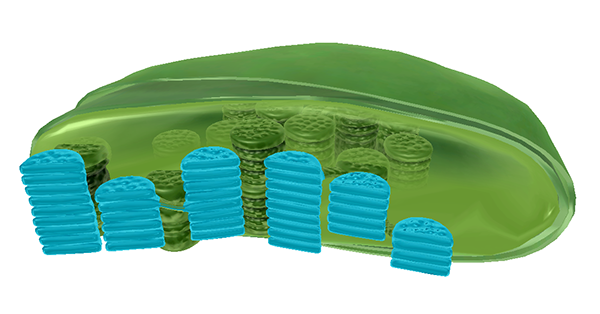 The thylakoid membranes are located within the chloroplasts of found cells. Prototype from Visible Biological science .
The thylakoid membranes are located within the chloroplasts of found cells. Prototype from Visible Biological science .
The chlorophyll molecule—specifically chlorophyll a, in this case—is part of a complex called photosystem II. When the energy from sunlight excites an electron in chlorophyll a plenty for it to leave and be passed on to another molecule, that departure leaves an "energy vacuum" in its wake. This vacuum is powerful plenty that photosystem II splits a water molecule to restore the electron. Humans tin can't split water in a lab the same way plants can, then the calorie-free-dependent reactions of photosynthesis are truly remarkable and unique!
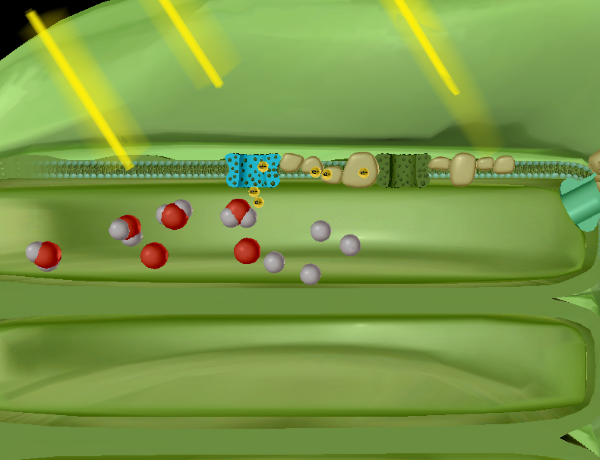
Photosystem II (highlighted in blue), water molecules beingness broken downwards, and electrons moving along to photosystem I. Epitome from Visible Biology.
Plants primarily get water from the soil. In vascular plants, tissue called xylem brings water from the roots to the leaves (the main site of photosynthesis).
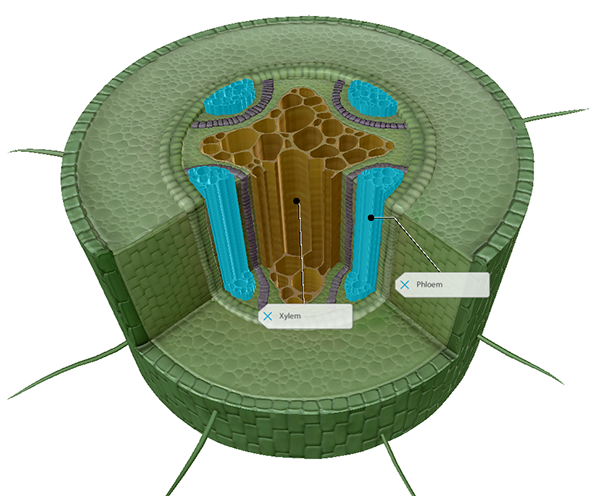 Vascular tissues are located at the eye of dicot roots. Image from Visible Biology.
Vascular tissues are located at the eye of dicot roots. Image from Visible Biology.
Water molecules are composed of two hydrogen atoms and one oxygen atom. After a water molecule is cleaved down, its hydrogen ions are used to create ATP. These hydrogen ions help an enzyme chosen ATP synthase add another phosphate group to ADP (adenosine diphosphate).
The oxygen atom from each disassembled water molecule joins up with another to form O2 (oxygen gas), which is released as a waste product product through openings in the leaves chosen stomata.
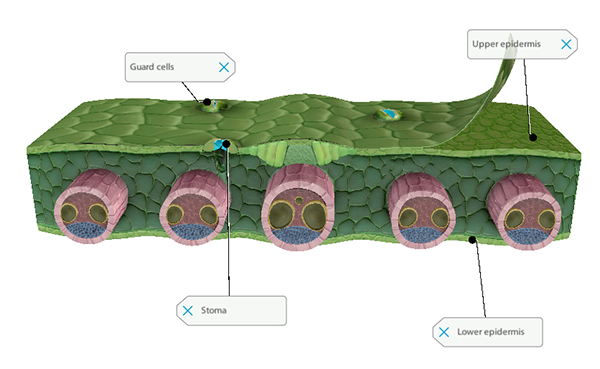 Stomata can be found on the upper and lower surfaces of monocot leaves. Image from Visible Biology.
Stomata can be found on the upper and lower surfaces of monocot leaves. Image from Visible Biology.
The electron that has been moving along the thylakoid membrane eventually arrives at some other chlorophyll-containing protein complex called photosystem I. At this point, it joins forces with some other excited electron. An enzyme called NADP+ uses these electrons and a passing hydrogen ion to build the free energy-conveying molecule NADPH.
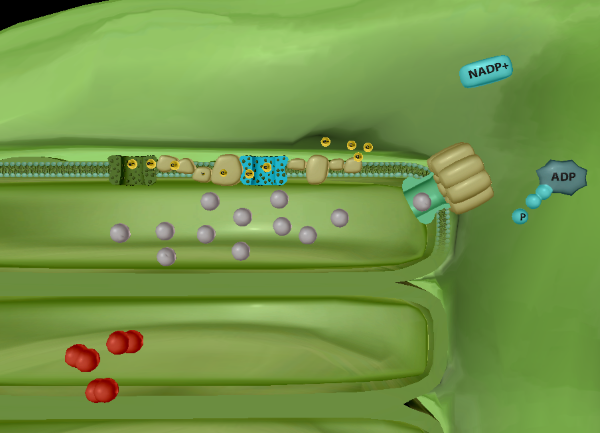
Photosystem I is highlighted in blue. Oxygen from the cleaved-down h2o molecules is released equally O2. With the help of the hydrogen ions and electrons, ADP will exist converted to ADP and NADPH will be built. Image from Visible Biological science.
Once the light-dependent reactions are complete, free energy from sunlight has successfully been converted into chemical energy, which volition exist used in the adjacent series of steps in photosynthesis—the low-cal-independent reactions—to assemble sugar molecules.
2. Low-cal-independent reactions (aka the Calvin cycle)
The adjacent phase of photosynthesis is a series of reactions that don't crave lite energy from the lord's day (photons). Therefore, they're widely referred to as light-independent reactions or the Calvin bike. (The one-time term "dark" reactions can be misleading, since light-independent reactions don't have to take place in the absenteeism of low-cal, or at nighttime—they merely aren't fueled by light like the light-dependent reactions.)
Photosynthesis: light-independent reactions
| Goal | Utilise stored chemical energy to "fix" CO2 and create a product that can be converted into glucose |
| Location | Chloroplasts - stroma |
| Input | CO2, NADPH, ATP |
| Output | NADP+, ADP, G3P (two G3P tin can be made into C6H12Ohalf dozen ) |
The goal of the calorie-free-independent reactions is to "fix" carbon from carbon dioxide into a form that can be used to build carbohydrates (sugars), such as glucose.
An enzyme called RuBisCo combines a molecule of carbon dioxide with a molecule called ribulose biphosphate (RuBP), which contains five carbon atoms. The result is a 6-carbon intermediate (carboxylated RuBP), which is cleaved down into two 3-carbon molecules (3-phosphoglycerate).
With the help of ATP and NADPH, each three-phosphoglycerate molecule gets a hydrogen atom, condign glyceraldehyde-iii-phosphate, or G3P.
Two molecules of G3P are used to make i molecule of glucose (which, if y'all recall, has 6 carbon atoms). Typically, one "instance" of the Calvin cycle uses six molecules of carbon dioxide at once, meaning that twelve G3P molecules are produced. 2 of these are used to produce a molecule of glucose and the rest are recycled back into RuBP, so the bike can continue.
What is cellular respiration?
Humans, like other animals, are heterotrophs. Nosotros can't brand our ain food via photosynthesis, so nosotros take to eat other organisms to gain glucose, which powers the process of cellular respiration in our bodies. Cellular respiration is the process that breaks downwardly glucose and produces ATP (a course of stored energy that cells use to comport out essential processes).
Here is the basic chemic formula for cellular respiration:
C6H12O6 + 6O2 → 6CO2 + 6H2O + (approximately) 38 ATP
In organisms that deport out aerobic cellular respiration—that is, cellular respiration that uses oxygen—in that location are 4 main steps involved in breaking down glucose to produce ATP: glycolysis, pyruvate oxidation, the citric acid wheel (Krebs wheel), and oxidative phosphorylation. Nosotros accept a more detailed weblog post dedicated to cellular respiration, but nosotros'll also quickly go over each footstep of aerobic cellular respiration in the following sections.
ane. Glycolysis
The first phase of cellular respiration, glycolysis, is the initial breakdown of glucose into pyruvate—1 molecule of glucose produces 2 molecules of pyruvate. On its own, glycolysis doesn't generate very much ATP. In fact, two ATP molecules are required to brainstorm glycolysis in the start place. What's really important about glycolysis in aerobic respiration is that it provides the fabric needed for the next step of cellular respiration: the citric acid cycle, also known every bit the Krebs bike.
Cellular respiration: glycolysis
| Goal | Intermission down glucose into pyruvic acrid (pyruvate) |
| Location | Cytoplasm of cell |
| Input | C6H12O6, ATP |
| Output | ATP, Pyruvate (C3HivOthree), NADH |
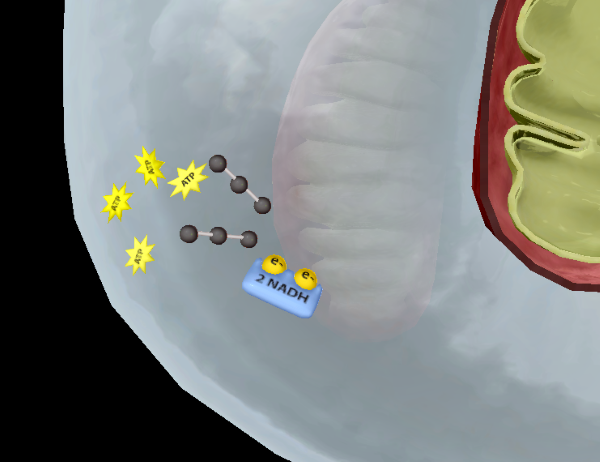
The results of glycolysis: iv ATP, 2 pyruvate molecules, and 2 NADH. Image from Visible Biology.
Notation: Since glycolysis doesn't require oxygen, it'southward also role of anaerobic cellular respiration. You tin read more about metabolism in the absence of oxygen in this chapter from OpenStax Biology (2e).
Glycolysis takes place in the cytoplasm of animal and plant cells, whereas the subsequent steps of cellular respiration have identify in the mitochondria.
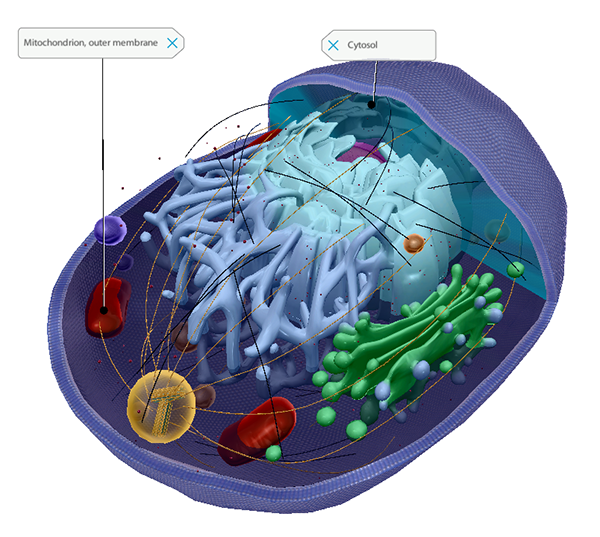 The cytoplasm contains cytosol, the jelly-like substance filling the inside of the cell. Image from Visible Biology.
The cytoplasm contains cytosol, the jelly-like substance filling the inside of the cell. Image from Visible Biology.
ii. Pyruvate oxidation
Before the citric acid cycle can begin in earnest, the pyruvate molecules produced during glycolysis lose their carboxyl groups and combine with coenzyme A to form acetyl-CoA. The carbon molecules that are removed during this process are released as carbon dioxide.
3. Citric acid cycle (Krebs bike)
The citric acid cycle takes place twice per molecule of glucose that was cleaved downward in the previous footstep—one "turn" of the citric acrid cycle occurs for each molecule of acetyl-CoA.
During each of these 2 turns, the molecule of acetyl-CoA goes through a series of chemical reactions. The energy from these reactions (in the form of electrons) is captured in the "free energy carrier" molecules NADH and FADH2. Two more molecules of carbon dioxide and another molecule of ATP are also produced.
Cellular respiration: citric acid cycle
| Goal | Capture free energy from chemic reactions, produce a little chip of ATP |
| Location | Mitochondria - matrix |
| Input | 2 Acetyl-CoA |
| Output | ATP, NADH & FADH2 (free energy carriers), CO2 (waste material production) |
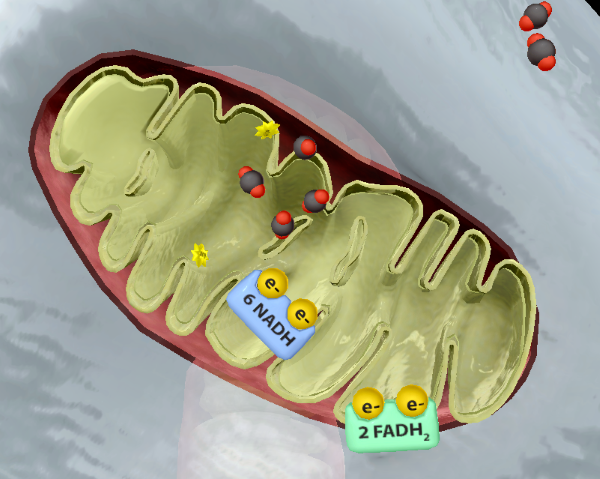
The results of the citric acrid cycle: 2 ATP, 6 NADH, two FADH2, and 4 COtwo (waste matter production). Prototype from Visible Biology.
four. Oxidative phosphorylation
Oxidative phosphorylation, which includes the electron ship concatenation and chemiosmosis, is the part of aerobic cellular respiration that produces almost of the ATP. The electron transport chain uses high-energy electrons from FADH2 and NADH to pump hydrogen ions (H+) across the inner membrane of the mitochondrion, into the outer compartment.
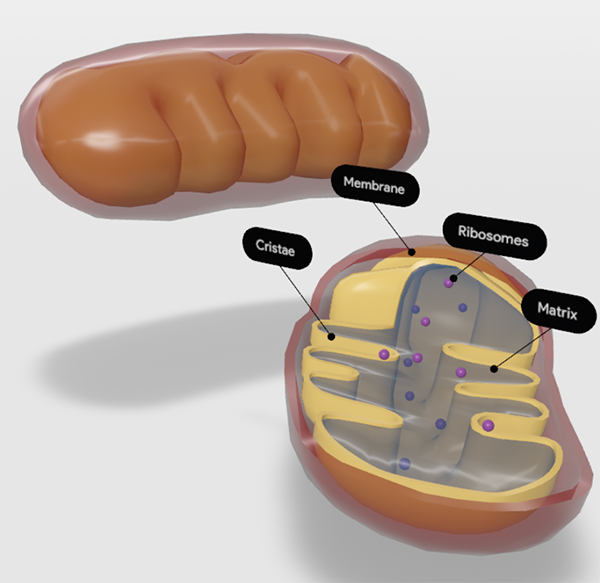
Mitochondria. The "membrane" label in this image refers to the outer membrane. The inner membrane is the yellow construction surrounding the matrix. Bank check out more than AR models on the Biology Learn Site.
Every bit a result of the electron transport chain, in that location are more positively charged ions on i side of the membrane than the other. As these ions travel back across the membrane to restore equilibrium, they pass through (and "power") an enzyme called ATP synthase, which turns molecules of ADP into ATP by adding a third phosphate group.
Cellular respiration: oxidative phosphorylation
| Goal | Employ stored free energy from the citric acid cycle to power ATP synthase and generate ATP |
| Location | Mitochondria - inner membrane |
| Input | Electrons Oxygen—information technology is the final acceptor for "spent" electrons |
| Output | Lots of ATP, HtwoO (waste product product) |
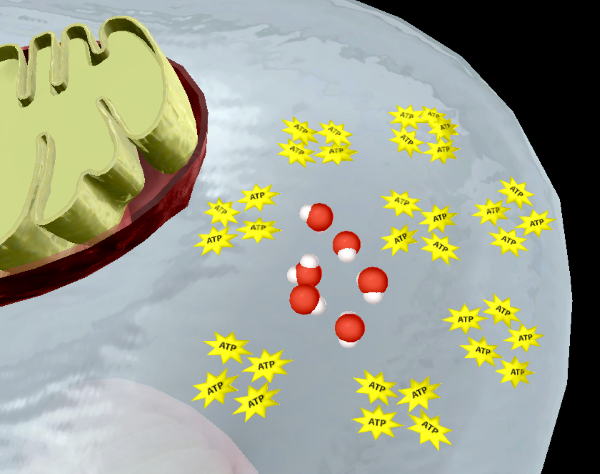
The results of oxidative phosphorylation. So much ATP, and also some water (waste product)! Epitome from Visible Biology.
How are photosynthesis and cellular respiration connected?
When I think about the connections betwixt photosynthesis and cellular respiration, I can't assistance merely start singing "Circumvolve of Life" from The Lion Male monarch in my head. Why? Because the products of photosynthesis are required for cellular respiration, and the products of cellular respiration tin exist used to power photosynthesis.
Putting the chemic formulas for these processes side-by-side shows this quite clearly:
Photosynthesis: 6CO 2 + 6H 2 O + Sunlight → C 6 H 12 O 6 + 6O 2
Cellular Respiration: C 6 H 12 O 2 + 6O two → 6CO ii + 6H 2 O + (approximately) 38* ATP
*The number of ATP molecules produced tin vary. 38 ATP is the theoretical maximum yield for the metabolism of i molecule of glucose.
The nutrient that plants make (glucose) and the waste product from producing that food (O2 ) give animals like us the materials we need to carry out aerobic cellular respiration. We breathe in the oxygen from the air and either eat plants or other animals—either way, plants and their delicious glucose are at the root of our food web . In return, humans and other organisms that acquit out aerobic respiration put the waste matter products from this procedure (mainly CO2) back into the atmosphere.
Plants carry out both photosynthesis and cellular respiration. They make their own food, and then break down those glucose molecules afterward, generating ATP to ability their cellular processes.
Fun fact! Photosynthesis by microorganisms called cyanobacteria is what put oxygen into the Earth'due south atmosphere in the first place. These organisms first produced oxygen betwixt 2.7 and two.eight billion years ago, and oxygen became a significant portion of the atmosphere by around 2.45 billion years ago. This paved the way for oxygen-breathing animals like u.s. to evolve later.
Before we go, here'due south a handy chart comparing photosynthesis and aerobic cellular respiration. Happy studying!
| Photosynthesis | Cellular Respiration (Aerobic) |
| Chemical equation | 6CO2 + 6HtwoO → CsixH12O6 + 6O2 | C6H12O2 + 6O2 → 6CO2 + 6HtwoO + (approximately) 38 ATP |
| Input | Carbon dioxide, h2o, sunlight | Glucose, Oxygen |
| Steps | ane. Low-cal-dependent reactions
2. Lite-independent reactions (Calvin cycle) | 1. Glycolysis
2. Pyruvate oxidation
3. Citric acid wheel
4. Oxidative phosphorylation |
| Output | Glucose, oxygen | ATP, carbon dioxide, h2o |
| Associated organelle | Chloroplasts | Mitochondria |
| Office for the organism | Use calorie-free, water, and carbon dioxide to create nutrient for the organism in the form of sugar (glucose) | Use glucose to brand a form of energy the organism can use in cellular processes (ATP) |
Be certain to subscribe to the Visible Body Web log for more anatomy awesomeness!
Are you an instructor? Nosotros take award-winning 3D products and resources for your beefcake and physiology course!Learn more hither.
Boosted Sources:
- The Amoeba Sisters: Photosynthesis and the Teeny Tiny Paint Pancakes
- Crash Course Biology: Photosynthesis
- Khan Academy: Cellular Respiration Review
- OpenStax Biology 2e: Metabolism without Oxygen
- Principles of Biological science: An Overview of Cellular Respiration
- TEDed: Nature'due south Smallest Mill
 The thylakoid membranes are located within the chloroplasts of found cells. Prototype from Visible Biological science .
The thylakoid membranes are located within the chloroplasts of found cells. Prototype from Visible Biological science . 
 Vascular tissues are located at the eye of dicot roots. Image from Visible Biology.
Vascular tissues are located at the eye of dicot roots. Image from Visible Biology.  Stomata can be found on the upper and lower surfaces of monocot leaves. Image from Visible Biology.
Stomata can be found on the upper and lower surfaces of monocot leaves. Image from Visible Biology. 

 The cytoplasm contains cytosol, the jelly-like substance filling the inside of the cell. Image from Visible Biology.
The cytoplasm contains cytosol, the jelly-like substance filling the inside of the cell. Image from Visible Biology. 


0 Response to "What Things Are Recycled Used Over and Over Again During Photosynthesis and Respiration"
Post a Comment